Gil (partially found South Korean comic; 1966): Difference between revisions
From The Lost Media Wiki
KalaGatito (talk | contribs) (Created page with "thumb|319x319px|Volume 1 '''Gil''' (Korean: 길) is a South Korean comic series published by Oh Myung-Cheon. The comic consists of a total...") |
KalaGatito (talk | contribs) No edit summary |
||
| Line 1: | Line 1: | ||
[[File:Gil - Oh myung choen.jpg|thumb|319x319px|Volume 1]] | [[File:Gil - Oh myung choen.jpg|thumb|319x319px|Volume 1]] | ||
'''Gil''' (Korean: 길) is a South Korean comic series published by Oh Myung-Cheon. The comic consists of a total of 6 volumes and deals with the adventures of the main character, Kim Gil. The background of the comic is Korea during the Japanese colonial era in the 1930s. | '''Gil''' (Korean: 길) is a South Korean comic series published by Oh Myung-Cheon. The comic consists of a total of 6 volumes and deals with the adventures of the main character, Kim Gil. The background of the comic is Korea during the Japanese colonial era in the 1930s. | ||
This comic was very popular with South Korean children in the 60s, but much of the material was lost due to the South Korean government's censorship laws in the late 1960s. Currently, only a few collectors seem to own the full volume of the comic. | This comic was very popular with South Korean children in the 60s, but much of the material was lost due to the South Korean government's censorship laws in the late 1960s. Currently, only a few collectors seem to own the full volume of the comic. | ||
== Reception == | |||
The comic's art style caught the attention of Korean netizens.[https://theqoo.net/square/1769539637] | |||
== Gallary == | == Gallary == | ||
Revision as of 07:17, 16 December 2022
Gil (Korean: 길) is a South Korean comic series published by Oh Myung-Cheon. The comic consists of a total of 6 volumes and deals with the adventures of the main character, Kim Gil. The background of the comic is Korea during the Japanese colonial era in the 1930s.
This comic was very popular with South Korean children in the 60s, but much of the material was lost due to the South Korean government's censorship laws in the late 1960s. Currently, only a few collectors seem to own the full volume of the comic.
Reception
The comic's art style caught the attention of Korean netizens.[1]



